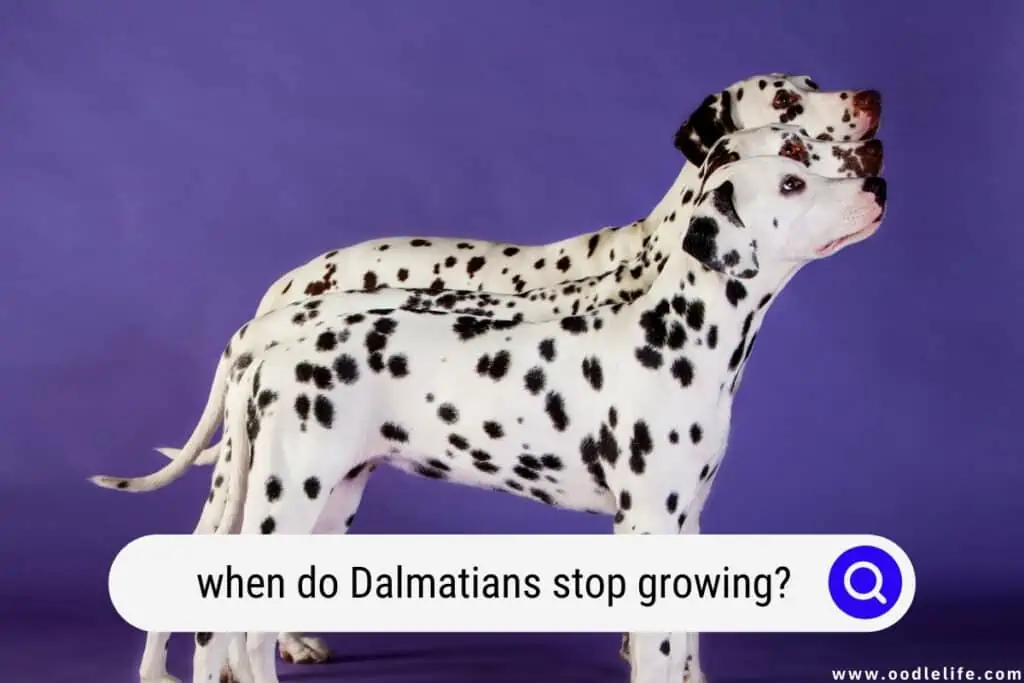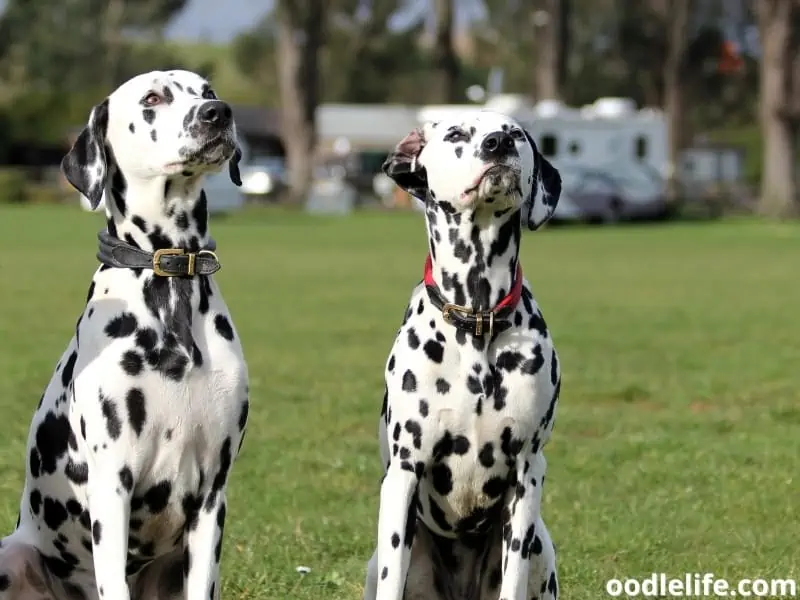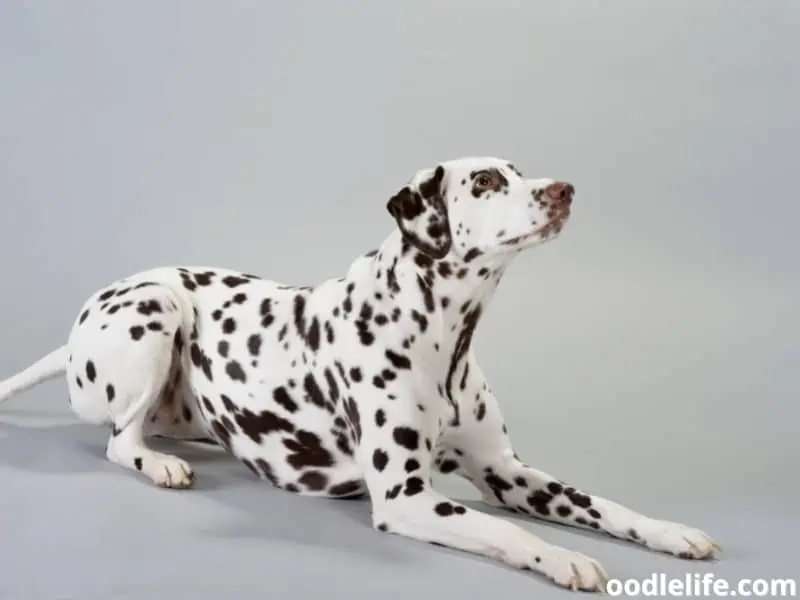When Do Dalmatians Stop Growing?
Many Dalmatian owners are surprised at how much their spotted Dalmatian puppies grow and keep growing. So, when do Dalmatians stop growing?
The answer depends on several things, including whether your dog is male or female. Generally, the average Dalmatian takes about 16 months to reach full-grown status. Many factors go into whether that happens on schedule, sooner, or a little later.

The following is what you can expect from your Dalmatian as it grows from being a puppy into a mature dog.
General Dalmatian Growth Trends
Many factors can affect how big a Dalmatian will get. So when do Dalmatians stop growing, and how will you know when their growth spurts have stopped?
The following are some height and weight statistics of the average Dalmatian:
Males Grow At a Slower Pace
The average male Dalmatian takes a bit longer to grow than the average female because they typically grow more muscle mass.

Height
Dalmatians reach their full height in about 12 months. The 12-month benchmark applies to both males and females. Twelve months is usually the outside threshold for a Dalmatian to gain height.
Occasionally, a Dalmatian will continue to gain height after a year, but the standard time is 12 months.

Weight
It takes about 16 months for Dalmatians to get to their total weight. Females tend to reach the threshold sooner than males. Many males grow through the 16-month mark, but most male Dalmatians reach their ideal weight at 16 months.

Average Sizes for Males and Females
Males tend to be bigger and grow to as much as 24 inches in height. The range for males is 22 to 24 inches. Their weight has a wider variance as they can weigh anywhere from 50 to 70 pounds.
Females will grow to a maximum of 22 inches high on average. They will usually fall between 19 and 22 inches and weigh between 45 and 60 pounds.
These estimates are average heights and weight. Some dogs might be smaller, and some will grow larger. It is not uncommon, for instance, to have a male Dalmatian taller than 24 inches, although that does not usually happen.

Growth Patterns
A healthy female Dalmatian will weigh between 14 and 21 pounds at three months. They will add weight up to 38 pounds after six months. At one year, they should weigh between 34 and 50 pounds.
Males have different growth patterns. The average male will reach between 14 and 26 pounds when they reach three months. At six months, they will be between 25 and 49 pounds.
At one year old, their weight can range from the mid-30s to mid-60s.
Female Dalmatian Growth Chart
Female Dalmatians tend to grow faster than males.
| Age | Weight |
| 3 months | 14 to 21 lbs |
| 6 months + | Up to 38 lbs |
| 12 months | 34 to 50 lbs |
Male Dalmatian Growth Chart
Although male Dalmatians grow at a slower rate than females, their fully-grown weight is more substantial.
| Age | Weight |
| 3 months | 14 to 26 lbs |
| 6 months + | 25 to 49 lbs |
| 12 months | 35 to 65 lbs |
Weight Issues
The weight of Dalmatians can also fluctuate. Like humans, a Dalmatian that spends a lot of time inactive but eats like an active dog will be heavier and can become overweight or even obese. Overweight Dalmatians usually must be put on a special diet and exercise regimen to help them shed weight.
Overweight Dalmatians, like all overweight dogs, and humans, can develop health issues. Because Dalmatians are prone to develop hip dysplasia, excessive weight can exacerbate the condition and even lead to it. Hip dysplasia happens when the hip joint deteriorates.
Dysplasia will lead to limited mobility and even loss of use of the hind legs if not treated.
Other health issues that excess weight can lead to include, but are not limited to:
- Heart problems
- Obesity
- Dental issues (due to eating more and poor dental hygiene)
- Other orthopedic and skeletal issues
As with other dogs and humans, the key to beating canine obesity or even being slightly overweight rests with diet and exercise. One side benefit to getting an overweight Dalmatian back to its optimum weight is that the owner can exercise by walking the dog regularly.

Warning Signs
As mentioned, these estimates are average. Your Dalmatian might be slightly taller or shorter or weigh more or less than the projections. You should only start worrying if your puppy is far behind in weight or exceeds the averages based on their age by a lot.
Another warning sign is if your Dalmatian suddenly loses weight or gains weight rapidly. A vet visit is in order if your animal is 5 pounds under the average or 5 pounds over the maximum expected weight or if they lose or gain that much weight in a short period.
One trick to helping them lose weight is to exercise them for five minutes a day multiplied by how many months they have been alive. So, if your puppy is six months old, it should get about a half-hour of playtime per day. You do not have to do this all in one shot.
The goal is to build enough minutes a day to equal that number.

Growth Influences
A healthy Dalmatian’s growth is affected by several factors. Here are the most common aspects that influence a Dalmatian’s growth:
Genetics
Like humans, a dog’s genetics help determine its size, weight, intelligence, etc. Dalmatian genetics do not usually affect the size of the dog directly, but there are a few trends worth noting:
- Big Dalmatian parents will generally have larger offspring.
- Small Dalmatian parents will usually have normal-sized to slightly smaller offspring.
- Mixed sizes among parents will not affect size much as there is no dominant size gene.
In addition, males will usually be a little larger than females. If you have a male puppy that is smaller, it will usually catch up in size quickly, depending on a few different factors.

Nutrition
A well-balanced diet is critical to your growing puppy and is key to keeping it healthy throughout its life. As puppies grow, particularly from months 2 through 16, your Dalmatian will need a lot of calories. Those will diminish slightly as your animal approaches 18 months, depending on how active your Dalmatian is.

Physical Activity, Planned Exercise, and Unplanned Playing
As your Dalmatian moves through its growth period, it will require a lot of calories because it is a bundle of constantly moving energy, just like all puppies. Exercise your dog regularly by taking it on walks and letting it roam free when appropriate.
Playtime is vital for your Dalmatian’s physical growth. Depending on what exercises you do with it, you can help your Dalmatian puppy develop motor skills and build muscles that will help it later in life. Because Dalmatians have a lot of energy, you will usually find them ready to chase a ball or play with other dogs.
If it is hot out, you want to ensure your animal is well hydrated and does not overdo the physical activity. Monitor your dog’s activities and encourage them to rest if they have been playing for an extended period.

So, When Do Dalmatians Stop Growing?
Your Dalmatian will grow to its natural height and weight by about 16 months. You can help your dog reach and maintain its ideal size and weight by exercising and feeding them well but not overfeeding them. By building healthy habits early, you can do your part to ensure your Dalmatian has a long and healthy life.